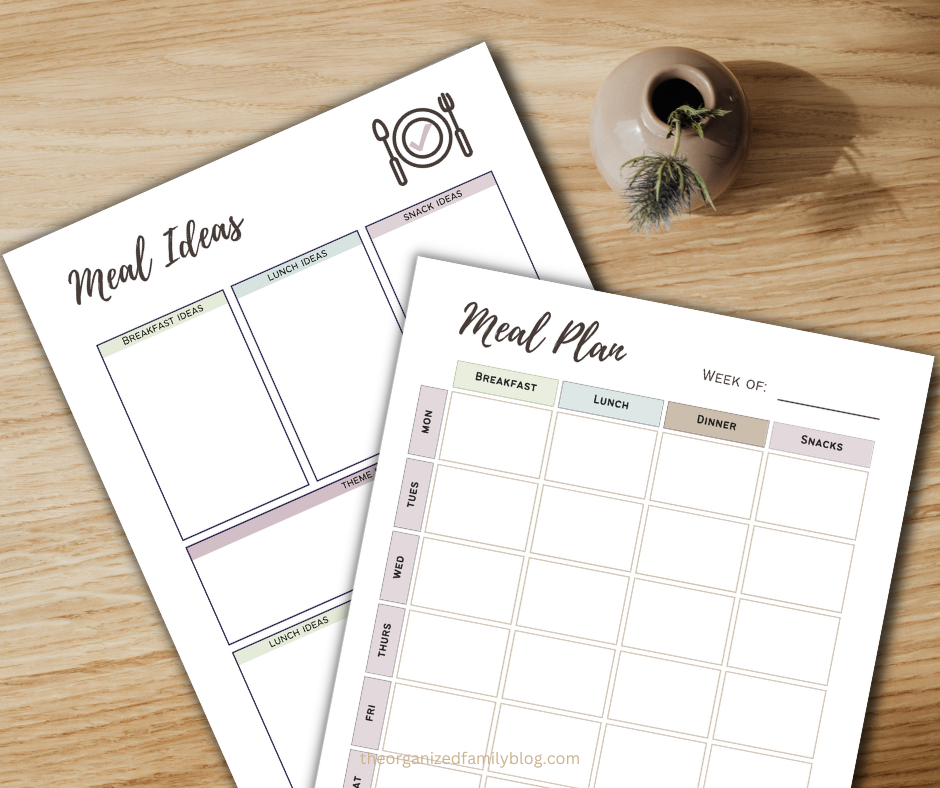10 Easy Tips for ADHD-Friendly Meal Planning (with FREE pdf)
Meal planning can be tricky for any of us trying to manage a family… Kids tend to be picky eaters, turn down new recipes without even giving them a try, and definitely do all that they can to avoid healthy foods 😅 Well, not always, but just to ensure we are not getting bored 😉
In the meantime, meal planning and striving for a healthy diet can be even harder for those families where kids (or other family members) are showing symptoms of attention deficit hyperactivity disorder (ADHD).
I did some research and collected 10 tips that can take ADHD-friendly meal planning to a different level!
ADHD-Friendly Family Meals
According to recent research,
“healthy dietary patterns were protective against ADHD, while unhealthy dietary patterns were found as risk to ADHD.”
But what does that mean? Is there a specific ADHD diet to follow?
Well, I have to admit, that I could not find a scientifically proven exact diet that would solve all issues with ADHD symptoms… however the same research also suggests in its results, that
“a diet high in refined sugar and saturated fat can increase the risk, whereas a healthy diet, characterized by high consumption of fruits and vegetables, would protect against ADHD or hyperactivity.”
But I would also suggest to seek for medical advice when planning your weekly meals based on any suggestions you find online.
So what are some common characteristics of healthy meals that can have a positive impact on symptoms of ADHD?
- Balanced Macronutrients: Meals that include a balance of carbohydrates, proteins, and healthy fats can help stabilize blood sugar levels, promoting sustained energy and focus.
- Omega-3 Fatty Acids: Foods rich in omega-3 fatty acids, such as salmon, flaxseeds, and walnuts, may be beneficial for brain health and cognitive function.
- Lean Proteins: High-quality protein sources like poultry, fish, tofu, and legumes provide essential amino acids that support neurotransmitter production and help maintain alertness.
- Whole Grains: Complex carbohydrates from whole grains like brown rice, quinoa, and oats release energy gradually, providing a steady supply of fuel for the brain.
- Colorful Vegetables: Incorporating a variety of colorful vegetables ensures a diverse range of vitamins, minerals, and antioxidants, which can contribute to overall cognitive health.
- Limited Refined Sugar: Minimizing the intake of refined sugars and processed foods can help prevent energy crashes and maintain stable mood and attention levels.
- Avoid Food Additives and Artificial Colors: The relationship between food additives and ADHD is a topic of ongoing research and debate. While there isn’t conclusive evidence that food additives directly cause ADHD, some studies suggest that certain additives may exacerbate symptoms or negatively impact behavior in some individuals with ADHD.
- Hydration: Staying well-hydrated is crucial for cognitive function. Water, herbal teas, and infused water with fruits can be good beverage choices.
Benefits of Meal Planning
Meal planning can offer numerous benefits for all families by providing structure, routine, and support for both parents and children. However for families with ADHD kids usually have additional issues to tackle too, so there is not much time to spend in the grocery store, and healthy “favorite recipes” might become life savers from time to time.
So if you are thinking about adding meal planning to your weekly routine, you might consider the following benefits:
- Consistency and Routine: ADHD kids often benefit from routine and predictability. Meal planning establishes regular meal times, contributing to a structured daily schedule that can enhance a child’s sense of security and stability.
- Reduced Decision-Making Stress: Having a meal plan in place reduces the stress associated with spontaneous decisions about what to cook, making daily life more manageable.
- Balanced Nutrition: Meal planning allows parents to ensure that their children receive a well-balanced and nutritious diet. This is crucial for supporting overall health, cognitive function, and managing ADHD symptoms.
- Time Management: Meal planning helps parents manage their time more efficiently, making it easier to prepare meals and handle other responsibilities. ADHD kids may struggle with time management, so teaching your Little Ones meal planning can be really helpful in improving time management skills!
- Minimized Food Waste: Meal planning minimizes food waste by providing a clear plan for what to put on your grocery list and what to cook.
- Healthy Snacking: Planning for healthy snacks ensures that there are readily available, nutritious options for snacking. This helps prevent impulsive choices that may not be as beneficial for a child’s health.
- Family Bonding: Meal planning encourages family involvement in the preparation process. Involving ADHD kids in choosing meals or helping with simple tasks fosters a sense of responsibility and strengthens family bonds.
- Skill Development: Involving ADHD kids in the meal planning and preparation process can contribute to the development of essential life skills, including organization, planning, and cooking.
How to Do ADHD Meal Planning?
As you might have already figured out, I love thinking in structures – and structuring even the “instructable” 😅
So by now, we have gone through what essential nutrients are beneficial to reach optimal brain function, and why meal planning is a great way to help you feed your family with easy meals and keep a well-balanced diet.
Now I would like to share 10 easy tips for ADHD-friendly meal planning for the whole family!
- Simple and Repetitive Menus: Stick to meals with straightforward recipes and familiar ingredients in your weekly meal plans. For example, grilled chicken with steamed vegetables and brown rice could be a go-to meal. Having variations of this meal throughout the entire week maintains simplicity and consistency.
- Weekly Meal Calendar: Create a visual calendar where each day is assigned a specific type of meal. For instance, designate Mondays for pasta, Tuesdays for stir-fries, and so on. This provides a predictable routine, reducing the need for daily decision-making. Btw you can also have leftover nights 😉
- Use Visual Aids: Employ visual aids like a magnetic meal planning board on your fridge. This could include pictures or icons representing each meal, helping your ADHD child visually comprehend the weekly meal plan. Printable meal planners and grocery shopping lists can be helpful as well.
- Prep Ingredients in Advance: Dedicate a day to prepping ingredients. For instance, chop vegetables for the week and store them in labeled containers. Having prepped ingredients makes it easier to assemble meals quickly during the week.
- Batch Cooking: Choose recipes that are suitable for batch cooking, such as soups, stews, or casseroles. Cook in large quantities and freeze individual portions for convenient and quick meals on days when you have little time.
- Color-Coded Organization: Organize your pantry and fridge with color-coded labels for different food groups. For example, use green for vegetables, red for proteins, and blue for grains. This makes it easy to locate ingredients and maintain an organized kitchen.
- Include ADHD-Friendly Snacks: Plan for easy and nutritious snacks. Pre-cut fruits, portioned nuts, or yogurt cups are examples of ADHD-friendly snacks that are readily available for impromptu snacking. This way you can avoid picking quick snacks full of artificial additives and food colorings.
- Set Alarms or Reminders: Use your phone to set alarms or reminders for meal preparation times. For example, set a reminder in the afternoon to start prepping for dinner. This helps you stay on track and ensures meals are ready on time. YOu can also use a grocery app to keep your grocery list up-to-date.
- Incorporate Favorites: Regularly include your child’s favorite meal in the plan. If they love tacos, designate a specific day for “Taco Tuesday.” This adds an element of excitement and familiarity to the meal schedule.
- Family Involvement: Encourage your ADHD child to contribute to the meal-planning process. Let them choose a meal for the week or involve them in simple tasks like setting the table. This involvement fosters a sense of responsibility and enjoyment during mealtimes.
Takeaway
Research suggests that a healthy diet, characterized by high consumption of fruits and vegetables, can be protective against ADHD symptoms, while diets high in refined sugar and saturated fats may pose risks. The key is to incorporate balanced macronutrients, omega-3 fatty acids, lean proteins, whole grains, and colorful vegetables, and to limit refined sugar and processed foods.

Meal planning offers various benefits for families with ADHD, promoting consistency, routine, and balanced nutrition. It reduces decision-making stress, minimizes food waste, and encourages healthy snacking. Family involvement in meal planning fosters bonding and skill development in ADHD children. To implement ADHD-friendly meal planning, adopt simple and repetitive menus, create a weekly meal calendar, use visual aids, prep ingredients in advance, and consider batch cooking.
Color-coded organization, inclusion of ADHD-friendly snacks, setting alarms, incorporating favorites, and involving the family further enhance the effectiveness of ADHD-friendly meal planning.
So with such a structured approach you can simplify the meal preparation process, support a well-balanced diet, and create a positive and organized family dining experience.








